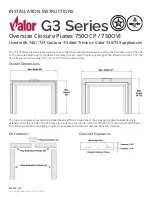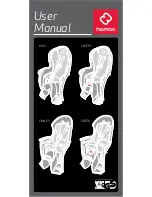
FG10239-1-0214
Page 15
OPERATION
Units with a Gas Control Valve
FOR YOUR SAFETY READ BEFORE LIGHTING
Figure 20 - Fiamma Burner Review Standard Pan with Valve
WARNING
Do not use this appliance if any part has been under water.
Immediately call a qualified service technician to inspect the
appliance and replace any part of the control system and any
gas control that has been under water.
All units with gas control valves must be lit by a Safety Pilot. For
standard units, the pilot is located at the right, rear, center of the
unit.
Follow these instructions exactly when lighting the appliance.
BEFORE LIGHTING, smell around the appliance area for gas. Be
sure to smell next to the floor, as L.P. gas is heavier than air and
will settle to the floor. Use only your hand to rotate the gas control
knob. Never use tools. If the knob will not turn by hand, do not try
to repair it; call a qualified service technician or installer. Force or
attempted repair may result in a fire or explosion.
WARNING
All gas burning appliances produce smoke and carbon mon-
oxide gas during operation. These fumes can be harmful if the
appliance is used in any other than a fully vented fireplace.
WARNING
A fireplace screen must be in place when this appliance is
in operation. Unless other provisions for combustion air are
provided, the screen shall have an opening(s) for introduction
of combustion air.
WARNING
When this decorative gas appliance is used in a fireplace
equipped with a combustion air kit and glass doors, the glass
doors should remain open during log set operation. This will
maximize the radiant heat provided to the surrounding area,
and minimize overheating of any valve installation. The glass
doors may be closed when the log set is not in use.
Figure 21 - Pilot Assembly, Standard Pan
Figure 22
Pilot Flame Adjustment
Figure 23
The pilot flame should be a soft blue in color and should surround
the last 1/2” of the thermocouple tip. The pilot adjustment screw
is located on the valve, just to the right of the control knob. See
Figure 22.
If the pilot flame must be adjusted, use a standard slotted screw
-
driver to turn the screw clockwise to reduce the flame, or counter-
clockwise to increase the flame. See Figure 22.
Curing Refractory Gas Logs
IMPORTANT
The hard refractory gas logs provided with this decorative gas
log set require curing the first time that they are put into opera
-
tion. You must follow the instructions given for curing the logs
to avoid cracking the logs with continued use.
After the initial lighting of the burner system, let the log set cool
down. Then, relight and allow to burn for another 30 minutes.










































